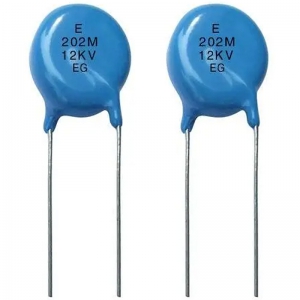
Through hole Ceramic Disc Capacitors, also known as ceramic or circular capacitors, are capacitors that use ceramic materials as their dielectric. This type of capacitor is widely used in various electronic circuits due to its simple structure, stable performance, and low cost.
characteristic:
Simple structure: Direct insertion ceramic capacitors are usually composed of a ceramic disc, with silver layers coated on both sides as electrodes, and connected by two metal leads.
Good stability: Ceramic materials have good temperature stability and time stability, allowing ceramic capacitors to maintain stable capacitance values in different working environments.
Compact size: Ceramic capacitors have a small volume and are suitable for circuit design with limited space.
Low price: Due to mature manufacturing processes and relatively low material costs, the price of ceramic capacitors is usually relatively cheap.
Non polarity: Ceramic capacitors are non-polar capacitors that can be used in AC circuits.
Application:
Power filtering: Ceramic capacitors are commonly used for filtering power lines to reduce electromagnetic interference and improve power quality.
Signal coupling: In analog signal processing, ceramic capacitors are used for signal coupling and decoupling.
Timing circuit: In RC oscillators and timing circuits, ceramic capacitors are used to set time and frequency.
Bypass and decoupling: In digital circuits, ceramic capacitors are used to bypass high-frequency noise and decoupling to improve circuit stability and reliability.
Type:
Ceramic capacitors can be classified into different categories based on the temperature coefficient of their dielectric materials:
COG (NPO): This is a temperature compensation capacitor with a very low temperature coefficient, suitable for applications that require extremely high temperature stability.
X7R: This type of capacitor has a moderate temperature coefficient, and the capacitance value does not change much with temperature, making it suitable for general use.
Y5V: This is a capacitor with a high temperature coefficient, and the capacitance value varies greatly with temperature. It is usually used in situations where the stability of the capacitance value is not high.
Packaging and dimensions:
The packaging of ceramic capacitors usually refers to the diameter and length of their outer shell, as well as the spacing between the leads. Common sizes include:
Small: Diameters range from 2mm to 6mm, and lengths range from 2mm to 8mm.
Medium size: Diameters range from 6mm to 12mm, and lengths range from 8mm to 15mm.
Large: with a diameter exceeding 12mm and a length possibly exceeding 15mm, suitable for specific high-power or high-voltage applications.
When selecting ceramic capacitors, factors such as capacitance value, operating voltage, temperature coefficient, packaging size, and cost need to be considered. Manufacturers usually provide detailed product specifications and data sheets to help users make appropriate choices. Due to the wide variety of ceramic capacitors, the most suitable ceramic capacitor product should be selected based on specific circuit design and space limitations.
Shenzhen Baoxin Chuang Electronics Co., Ltd.
Address: 45th Floor, SEG Plaza, 1002 Huaqiang North Road, Futian District, Shenzhen, Guangdong, China
Website: www.boxintron-ic.com
Tel: +86-0755-8355 3623/8322 8690/8322 8629/8322 8357
Fax: +86-0755-8366 0820
Email: service@boxintron.com
Electronic components with a single expert
Shenzhen Baoxin Chuang Electronics Co., Ltd. is committed to becoming the best IC supplier with single expert and IC agent
Strive to provide customers with one-stop electronic components procurement and IC supporting services
Tel: +86-0755-8355 3623 Fax Fox: +86-0755-8366 0820 Email: service@boxintron.com
Address: Room 4503, 45th Floor, SEG Plaza, 1002 Huaqiang North Road, Futian District, Shenzhen, Guangdong, China
![Shenzhen Baoxin Chuang Electronics Co., Ltd. [one-stop type of electronic components with one-only original authentic] Shenzhen Baoxin Chuang Electronics Co., Ltd. [one-stop type of electronic components with one-only original authentic]](templates/web/images/logo.png)